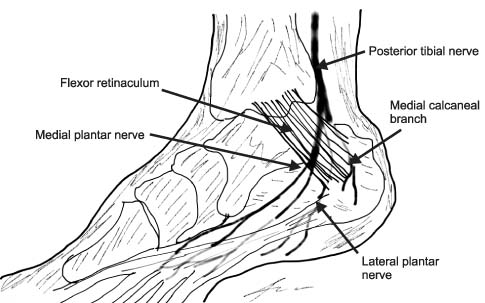J Korean Orthop Assoc.
2014 Oct;49(5):340-345. 10.4055/jkoa.2014.49.5.340.
Update on Management of Compressive Neuropathy: Tarsal Tunnel Syndrome
- Affiliations
-
- 1Department of Orthopedic Surgery, Korea University Guro Hospital, Seoul, Korea. dakjul@korea.ac.kr
- KMID: 2185169
- DOI: http://doi.org/10.4055/jkoa.2014.49.5.340
Abstract
- The tarsal tunnel is located beneath the flexor retinaculum, which connects the medial malleolus and calacaneus. The tarsal tunnel contains the posterior tibialis tendon, flexor digitorum longus tendon, posterior tibial artery and vein, posterior tibial nerve, and flexor halluces longus tendon. Tarsal tunnel syndrome is a compressive neuropathy of posterior tibial nerve and its branches under the flexor retinaculum. The etiologies of tarsal tunnel syndrome are space-occupying lesion, hypertrophied flexor retinaculum, osteophytes, tarsal coalition, varicose vein, and trauma. The symptoms are foot pain and hypoesthesia or paresthesia at dermatome according to involving nerve branches. Clinical diagnosis can be obtained from a detailed history and physical examination such as compressive test at the tarsal tunnel area. Ultrasonography and magnetic resonance imaging can reveal the space-occupying lesion, such as ganglion, lipoma, and neuroma. The initial treatments of tarsal tunnel syndrome are conservative management, such as physical therapy, night splint, and steroid injection. Surgical decompression is indicated after failure of conservative managements. Variable results of surgical treatment have been reported. Favorable result after decompression could be obtained from young patients, early onset symptoms, and space-occupying lesion.
MeSH Terms
Figure
Reference
-
1. Keck C. The tarsal-tunnel syndrome. J Bone Joint Surg Am. 1962; 44:180–182.
Article2. Lam SJ. A tarsal-tunnel syndrome. Lancet. 1962; 2:1354–1355.
Article3. Havel PE, Ebraheim NA, Clark SE, Jackson WT, DiDio L. Tibial nerve branching in the tarsal tunnel. Foot Ankle. 1988; 9:117–119.
Article4. Heimkes B, Posel P, Stotz S, Wolf K. The proximal and distal tarsal tunnel syndromes. An anatomical study. Int Orthop. 1987; 11:193–196.5. Kim JY, Lee HK, Cho J. Tarsal tunnel syndrome secondary to recurred schwannoma arising from the posterior tibial nerve. J Korean Foot Ankle Soc. 2014; 18:36–39.
Article6. Sung KS, Park SJ. Short-term operative outcome of tarsal tunnel syndrome due to benign space-occupying lesions. Foot Ankle Int. 2009; 30:741–745.
Article7. Ahmad M, Tsang K, Mackenney PJ, Adedapo AO. Tarsal tunnel syndrome: a literature review. Foot Ankle Surg. 2012; 18:149–152.
Article8. Baylan SP, Paik SW, Barnert AL, Ko KH, Yu J, Persellin RH. Prevalence of the tarsal tunnel syndrome in rheumatoid arthritis. Rheumatol Rehabil. 1981; 20:148–150.
Article9. Skalley TC, Schon LC, Hinton RY, Myerson MS. Clinical results following revision tibial nerve release. Foot Ankle Int. 1994; 15:360–367.
Article10. Reed SC, Wright CS. Compression of the deep branch of the peroneal nerve by the extensor hallucis brevis muscle: a variation of the anterior tarsal tunnel syndrome. Can J Surg. 1995; 38:545–546.11. Kinoshita M, Okuda R, Yasuda T, Abe M. Tarsal tunnel syndrome in athletes. Am J Sports Med. 2006; 34:1307–1312.
Article12. Machiels F, Shahabpour M, De Maeseneer M, Schmedding E, Wylock P, Osteaux M. Tarsal tunnel syndrome: ultrasonographic and MRI features. JBR-BTR. 1999; 82:49–50.13. Jung HJ, Lee SW, Jeong YM, et al. The usefulness of the preoperative magnetic resonance imaging findings in the evaluation of tarsal tunnel syndrome. J Korean Soc Radiol. 2012; 66:183–192.
Article14. Lau JT, Daniels TR. Tarsal tunnel syndrome: a review of the literature. Foot Ankle Int. 1999; 20:201–209.
Article15. Edwards WG, Lincoln CR, Bassett FH 3rd, Goldner JL. The tarsal tunnel syndrome. Diagnosis and treatment. JAMA. 1969; 207:716–720.
Article16. Alshami AM, Babri AS, Souvlis T, Coppieters MW. Strain in the tibial and plantar nerves with foot and ankle movements and the influence of adjacent joint positions. J Appl Biomech. 2008; 24:368–376.
Article17. Radin EL. Tarsal tunnel syndrome. Clin Orthop Relat Res. 1983; 181:167–170.
Article18. Nekoroski T, Paladini RD, Sauder DN, Frost GI, Keller GA. A recombinant human hyaluronidase sustained release gel for the treatment of post-surgical edema. Int J Dermatol. 2014; 53:777–785.
Article19. Reeve F, Laughlin RT, Wright DG. Endoscopic plantar fascia release: a cross-sectional anatomic study. Foot Ankle Int. 1997; 18:398–401.
Article20. Hofmeister EP, Elliott MJ, Juliano PJ. Endoscopic plantar fascia release: an anatomical study. Foot Ankle Int. 1995; 16:719–723.
Article21. Sammarco GJ, Chang L. Outcome of surgical treatment of tarsal tunnel syndrome. Foot Ankle Int. 2003; 24:125–131.
Article22. Takakura Y, Kitada C, Sugimoto K, Tanaka Y, Tamai S. Tarsal tunnel syndrome. Causes and results of operative treatment. J Bone Joint Surg Br. 1991; 73:125–128.
Article23. Bailie DS, Kelikian AS. Tarsal tunnel syndrome: diagnosis, surgical technique, and functional outcome. Foot Ankle Int. 1998; 19:65–72.
Article24. Pfeiffer WH, Cracchiolo A 3rd. Clinical results after tarsal tunnel decompression. J Bone Joint Surg Am. 1994; 76:1222–1230.
Article25. Bazaz R, Ferkel RD. Results of endoscopic plantar fascia release. Foot Ankle Int. 2007; 28:549–556.
Article26. Ahn JH, Kim KJ, Kim HY, Choy WS, Yang DS. Surgical treatment of tarsal tunnel syndrome. J Korean Foot Ankle Soc. 2007; 11:187–191.27. Franson J, Baravarian B. Tarsal tunnel syndrome: a compression neuropathy involving four distinct tunnels. Clin Podiatr Med Surg. 2006; 23:597–609.
Article



